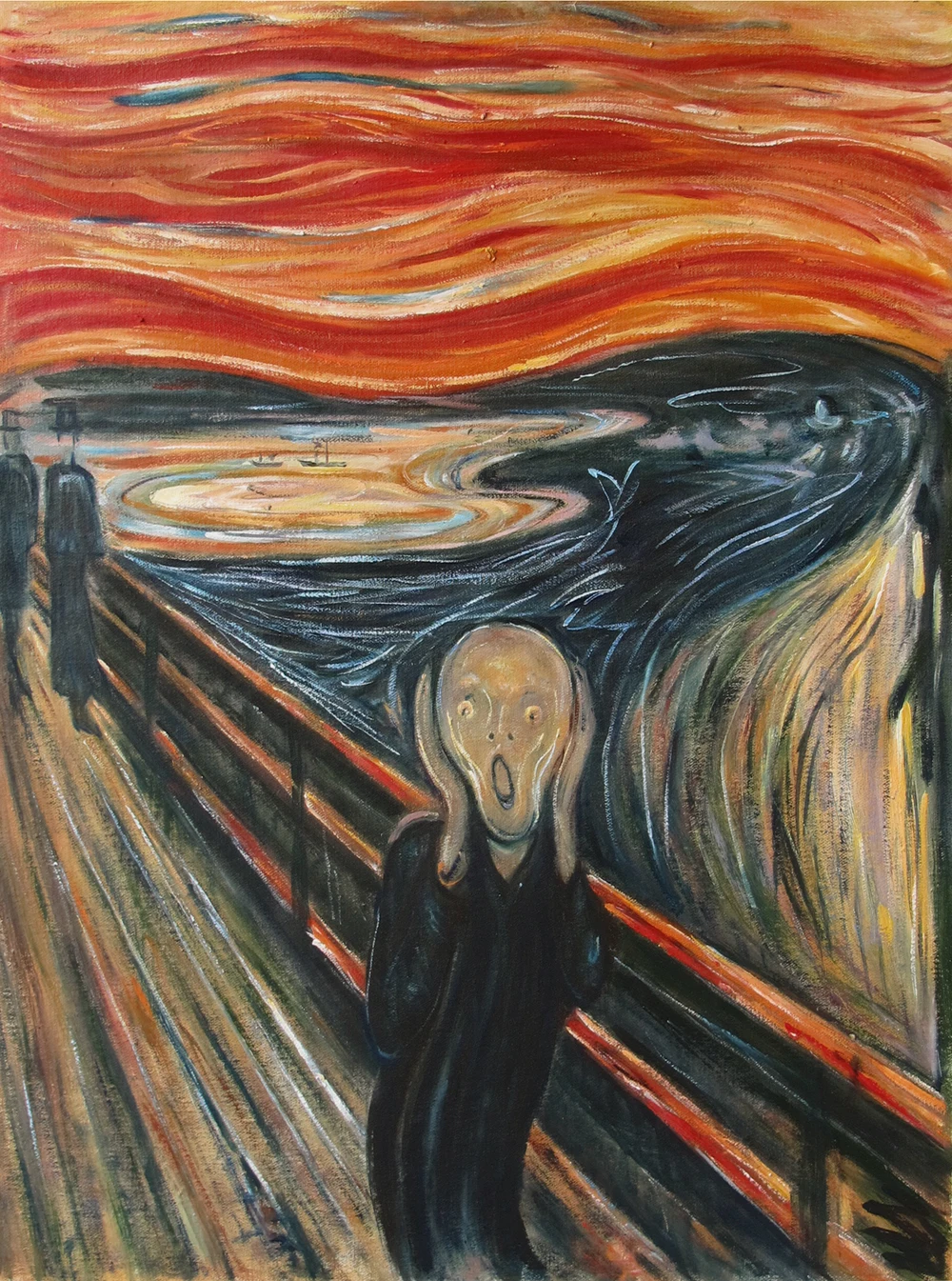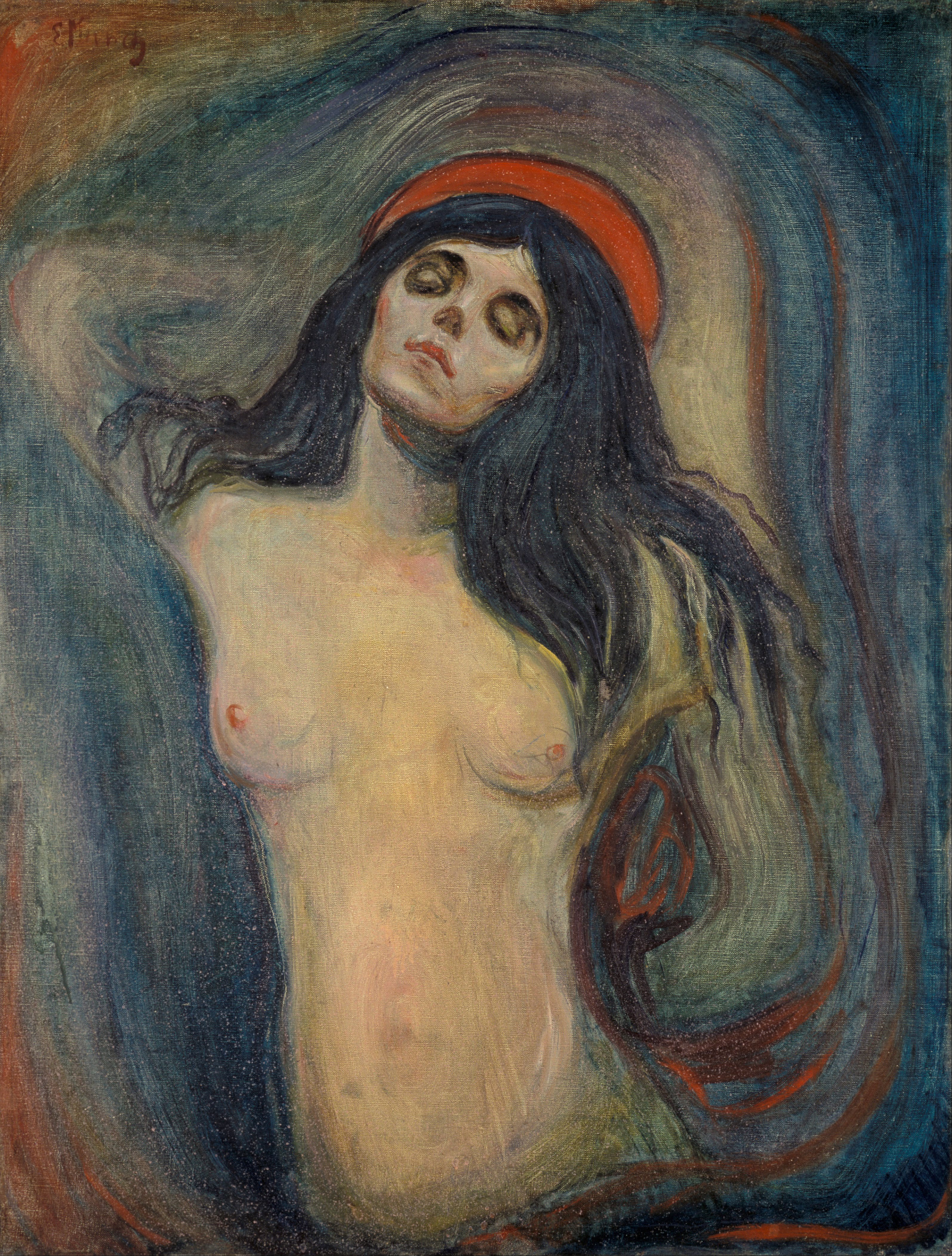Expressionism is a modernist movement, initially in poetry and painting, originating in Germany at the beginning of the 20th century. Its typical trait is to present the world solely from a subjective perspective, distorting it radically for emotional effect in order to evoke moods or ideas.
It tried to convey emotion and meaning rather than reality. Each artist had their own unique way of “expressing” their emotions in their art. In order to express emotion, the subjects are often distorted or exaggerated. At the same time, colours are often vivid and shocking.
Edvard Munch

Alive between 1863 and 1944, Edvard Munch was a Norwegian painter, whose best-known work, The Scream, has become one of the most iconic images of world art. His childhood was overshadowed by illness, bereavement and the dread of inheriting a mental condition that ran in the family.
When he was just 5 years old, his mother died from TB. Then a 9 years later when he was 14, his older sister also died from TB – this horrible event was the inspiration behind his series of six paintings and a number of lithographs, drypoints and etchings completed between 1885 and 1926. All record a moment before her death. They’re so haunting.

In his early 20s, he lived a bohemian lifestyle, and during this time, Hans Jæger who was a writer he was living with urged him to paint his own emotional and psychological state (‘soul painting’). From this would emerge his distinctive art style.
He was plagued throughout his life with depression, which he explored in his paintings. For instance, he wrote this in his diary “I was walking along the road with two friends – the sun was setting – suddenly the sky turned blood red – I paused, feeling exhausted, and leaned on the fence – there was blood and tongues of fire above the blue-black fjord and the city – my friends walked on, and I stood there trembling with anxiety – and I sensed an infinite scream passing through nature.” Which can obviously be interpreted as the inspiration behind The Scream (pictured below).

In The Scream, Munch used oil paints and oil paints thickened with beeswax and also oil crayons containing beeswax and Japan wax, as well as casein pastels, a paraffin wax crayon and at least one gum-bound paint.
A lot of his paintings have very wavy brushstrokes, they almost make the painting look like liquid. But almost all of them explore the darker subjects, like loneliness, depression, death, grief, anxiety, love, anxiety, jealousy and betrayal, but all were steeped in atmosphere.
But it wasn’t all doom and gloom, he also painted women in seductive poses, as most artists seem to. But even these are somewhat scary, something in his paintings always seems to be off, like in the painting below her limbs fade off into wispy, ghost-like tendrils, and her eyes are sunken, making her look very ill and thin, almost skeleton-like, which heavily contrasts with the idea of a happy, glamorous, seductive woman.

In Paris, he learned much from Paul Gauguin, Vincent van Gogh and Henri de Toulouse-Lautrec, especially their use of colour. In Berlin, he met Swedish dramatist August Strindberg, whom he painted.

Some of the major world events around the time of his life were; the invention of the telephone in 1876. The Wright brothers make the first controlled, sustained flight in heavier-than-air aircraft in 1903. World War 1 between 1914 and 1918. In the same year, a worldwide influenza epidemic strikes; by 1920, nearly 20 million are dead. World War 2 between 1939 and 1945. So Munch died before he could see the end of ww2.
My opinion of his work is that I absolutely love it, he wasn’t afraid to explore very controversial subjects, and he was able to paint his inner demons. I’m sure that painting was very therapeutic for him.
Francis Bacon

Alive between 1909 and 1992, Francis Bacon was an Irish-born British figurative painter known for his emotionally charged raw imagery and fixation on personal motifs.
Bacon had a very dark view of the world, and he also had a very abusive relationship with a man called Peter Lacy, who used to beat him up on a regular basis, and even once threw him out of a 2nd story window, which nearly caused Bacon to lose an eye, but all of this just made Bacon love him more. Both were heavy drinkers. It is thought that Bacon’s creative impulses were rooted in sexual pain and humiliation. His sadomasochistic obsessions seem to have influenced his art style significantly, as almost all of his paintings have horrifically mutilated figures screaming in pain and anguish. The painting below illustrates this and is also my favourite Francis Bacon painting.

He portrayed the people in his paintings as just chunks of meat that have been squished and battered into a messy pulp with bits of the human body sticking out at unnatural angles. They can be very hard to look at, but at the same time, they are fascinating and I absolutely love his paintings.

In his early twenties, he went to a Picasso exhibition, and the way that the artist used lines to convey deep emotional feelings really hit a chord with Bacon, so he went home and started drawing and painting for the first time, with watercolours. I think he later moved onto the painting with oil paints, which is what he used to paint the majority of his artwork.
For a while, he was good friends with the acclaimed artist Lucian Freud, who he painted. He once said that he felt like he could brutalise his friend’s faces more easily in his paintings than those of strangers.

Some of the major events in the world that happened in Bacon’s lifetime were; World War 1 between 1914 and 1918. In the same year, a worldwide influenza epidemic strikes; by 1920, nearly 20 million are dead. World War 2 between 1939 and 1945. The Cold War between 1947 and 1991.
I’ve loved Francis Bacon and his artwork since I first discovered his work a couple of years ago. I love how he really gets all of his deep anger and hatred of the world out in his paintings. I find him an extremely intriguing person. Looking at his paintings is a very visceral experience, and is one that really needs to be in person. When I went to the Tate, I found one of his triptychs, and it was so cool.
Lucian Freud
Alive between 1922 and 2011, Lucian Michael Freud was a British painter and draftsman, specializing in figurative art, and is known as one of the foremost 20th-century portraitists. He was born in Berlin, the son of Jewish architect Ernst L. Freud and the grandson of the famous psychologist Sigmund Freud.
He painted multiple self-portraits throughout his life, starting from when he was 25. Here’s one from later in his life.

He was an interesting man, as he hung out with, and painted all kinds of people, from low life criminals to high society aristocrats – he even painted the Queen at one point in his later career. He was also a massive womaniser, as he apparently had 100s of lovers and 14 confirmed children, and possibly at least 20 more.

As far as I can tell, he mainly used oil paints. He had a very slow method of painting; he would look at his human subject, then mix some oil paints together and would make a line on the canvas, then slapped the remainder of the colour onto the wall of his studio, then the process would repeat again and again until the painting was complete. Each painting took Freud a couple of years to paint.
He was good friends with Francis Bacon, who he painted (shown below), and Frank Auerbach. I have no doubt that these big shot fellow painters influenced his art.

Some of the major world events during his lifetime were; World War 2 between 1939 and 1945. The Cold War between 1947 and 1991. 9/11 in 2001.

He had a very objective style of painting; he wouldn’t try to portray his subjects as glamorous, as he would paint everything he saw, every fold, every crease, every wrinkle. The resulting paintings are very different to most figurative paintings, which often make the subjects look pretty, but Freud made his subjects look far from perfection, but this is actually a really nice and refreshing way of painting, as it shows people and their bodies in their most natural, objective states. They may look kind of gross, but he’s just showing real people and their real bodies. I like it.
Research
https://en.wikipedia.org/wiki/Expressionism
https://en.wikipedia.org/wiki/Edvard_Munch
https://www.iiconservation.org/node/3292
https://www.infoplease.com/history/us/us-history-progressive-era-and-world-wars-1900-1949
https://en.wikipedia.org/wiki/Francis_Bacon_(artist)
https://shop.mybluprint.com/art/article/painting-techniques-of-francis-bacon/
https://en.wikipedia.org/wiki/Lucian_Freud